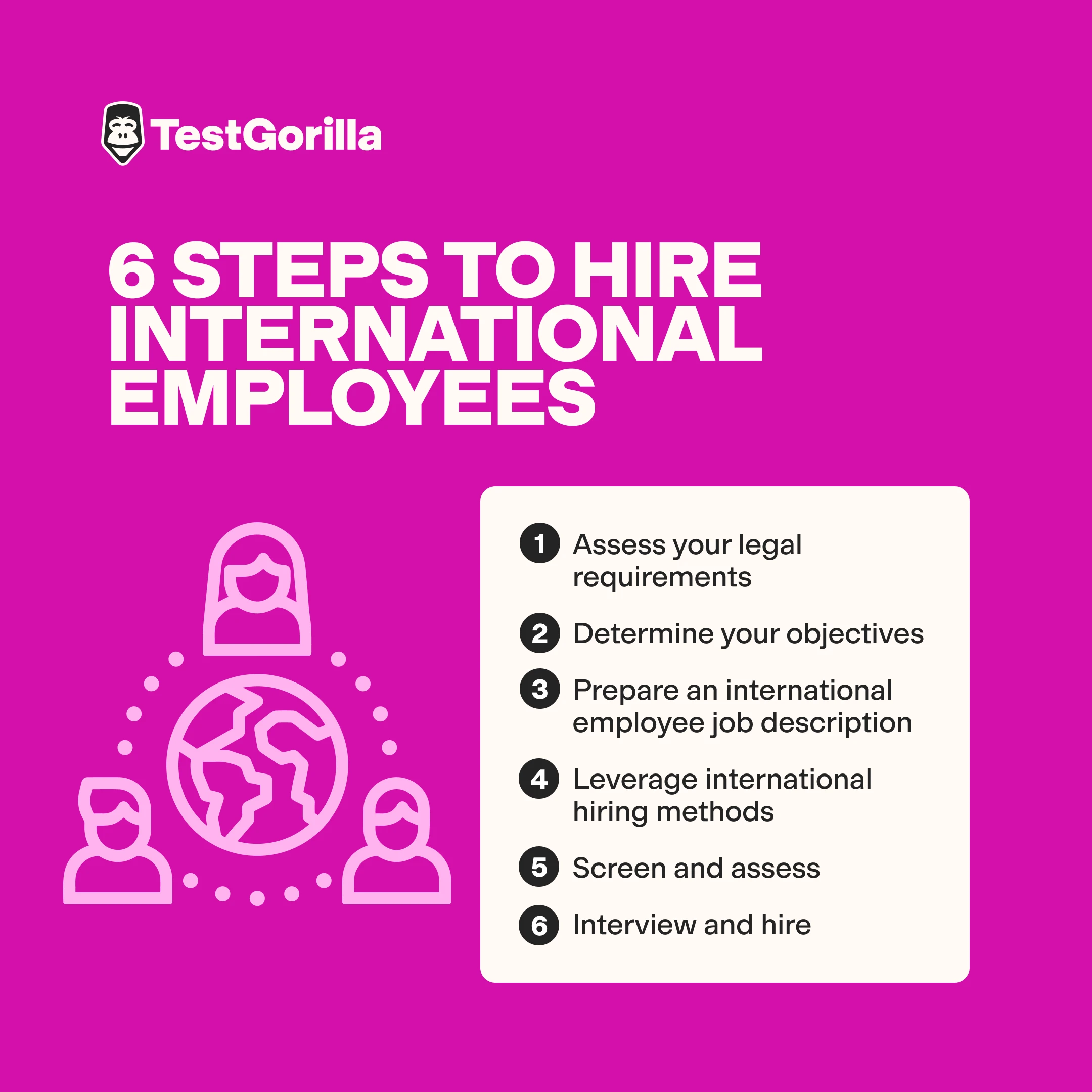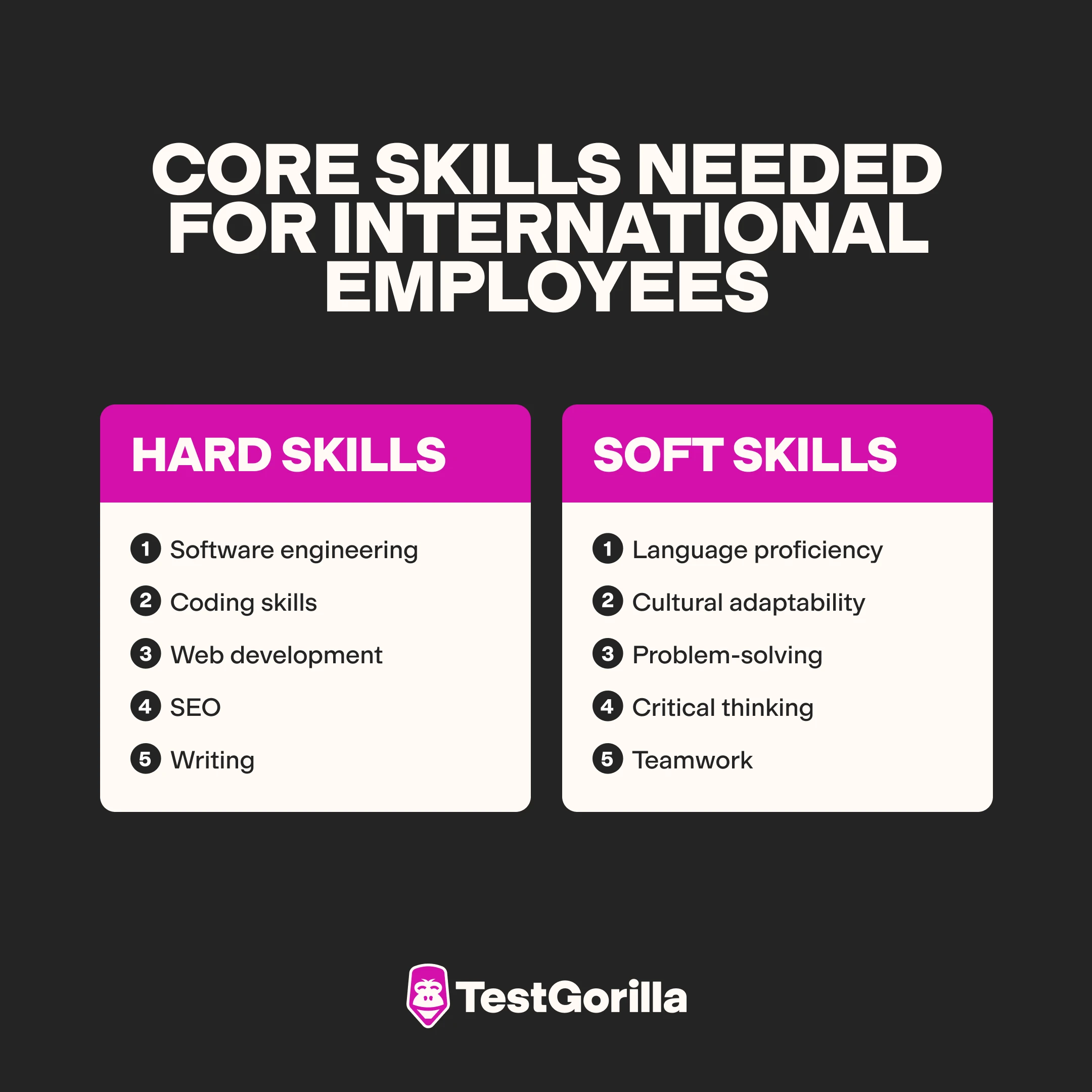Use remote-friendly assessment software to hire internationally
Remote work continues to thrive, and the barriers between global talent and businesses have been reduced. It’s the perfect time to use talent assessments to build a high-performing team of international employees.
Employing an international workforce comes with crucial business advantages. A culturally diverse team brings new energy, ideas, and insights to the table and creates a more dynamic and sustainable organization.
However, overseas hiring comes with legal and regulatory challenges, as well as an increased risk of bias in the candidate selection process. Learn how to hire international employees without bias in this in-depth guide to international hiring.
Why hire international employees? The 4 benefits of hiring from overseas
Hiring international employees is often challenging for small businesses and large conglomerates alike, but the benefits make it a worthwhile investment. Here are the four key advantages of hiring internationally:
Wider talent pool: If you restrict yourself to hiring candidates from your home country, you limit your access to top talent. Including international candidates translates into a better chance of finding the right person for the job.
Lower wages: U.S. companies pay the fourth highest wages in the world, averaging $4473.46 per month after tax. Workers based in most other countries have lower salary expectations, which gives you an opportunity to reduce payroll costs.
Increased diversity: The benefits of cultural diversity are well documented. However, the varied experience of international employees also enables businesses to enhance the company culture and find innovative solutions to complex problems.
Around-the-clock presence: An international team working across multiple time zones has the potential to be active and productive around the clock. This 24/7 presence is especially valuable for customer-facing teams.
How to hire international employees: 6 steps
Hiring internationally introduces some complications to the hiring process. To make sure you get it right, read on – we’ll show you how to hire international employees one step at a time.
1. Assess your legal requirements
Navigating legal requirements is one of the biggest challenges of hiring a foreign employee for U.S. employers.
If you hire an overseas employee to come and work inside the U.S., you need to petition the American government for an employment-based immigrant visa, a temporary (nonimmigrant) work visa (such as the H-1B visa), or a work permit.
If your sponsorship is successful and the worker is admissible to the U.S. under the provisions of the Foreign Labor Certification, they can apply for a visa.
However, there are limitations on the type and quantity of workers you may sponsor, and they change according to government priorities. If you want to petition for foreign workers to move to the U.S., we recommend consulting an immigration lawyer.
If you hire non-U.S. citizen remote workers based overseas, you won’t need to deal with the U.S. Citizenship and Immigration Services. However, you need to consider the tax implications. Hiring full-time employees overseas leaves you liable for withholding payroll taxes they need to pay to the IRS.
It’s possible to relieve foreign nationals of the requirement to pay U.S. taxes by treating them as international contractors. However, if you outsource work to contractors based outside the U.S., they need to complete an IRS tax form to declare their residency elsewhere.
When employing a full-time overseas worker, you’re also liable for contributing to their social security and paying for other employee benefits. Hiring overseas workers as contractors absolves you of these responsibilities in most cases as long as you avoid misclassification. Another alternative is to work with an employer organization in your overseas worker’s country. We’ll cover this and other international hiring methods later.
2. Determine your objectives
Figure out what you need from the international role and the person who fills it.
Start by creating a skills-based candidate profile. These profiles help you stay away from biased hiring based on arbitrary criteria, like educational background or prior experience. Instead, they focus on the skill set a candidate needs to thrive in the role.
Knowing your objectives is especially important when hiring overseas, as typical levels of education or experience vary between countries. Without a skills-based candidate profile, you may be excluding a diverse pool of applicants before you even start hiring.
Based on the candidate profile, build a role description that sets out your expectations for the position. Setting goals like this helps you clarify your intent in hiring and makes it easier to stay objective without the process becoming time-consuming.
3. Prepare an international employee job description
A job description for an international employee should have a lot in common with one meant for a domestic candidate, although you must mention your willingness to hire from abroad (or remotely).
The description should also explain the assistance you plan to provide for global market candidates as they navigate immigration and tax bureaucracy.
Here’s a sample job description template for a remote/overseas sales manager.
Company Overview: Our company is a leading provider of [product/service] in [industry]. We have a presence in [list countries]. We are seeking an experienced Sales Manager to [key aims of the role].
Job Description: As a Sales Manager, you will be responsible for [key aims of the role]. This position will report to [manager].
Responsibilities:
Develop and implement comprehensive sales plans to [meet aims of the role].
Identify and pursue new business opportunities through [core methods].
Manage and nurture relationships with [relevant parties].
Conduct new market analysis and stay updated on [industry data].
Collaborate with cross-functional teams to ensure effective execution of sales strategies.
Prepare and deliver sales presentations and product demonstrations.
Negotiate and close sales agreements, contracts, and pricing terms with customers.
Provide sales forecasts, reports, and analyses to the management team, showing [key insights].
Stay informed about [legal and regulatory considerations].
Qualifications:
Bachelor’s degree in [relevant field].
Proven track record of success in sales.
The capability to work remotely and cooperate with global teams.
Excellent interpersonal and communication skills.
Project management skills.
Analytical mindset with the ability to interpret market data and insights.
Proficiency using [relevant software].
Fluency in English is required. Proficiency in additional languages is highly desirable.
4. Leverage international hiring methods
If you’re interested in hiring international employees, you need to know where to look for them. In this section, we’ll explain how to hire employees from other countries.
Here are some of the options you have:
Open a local legal entity. An overseas office establishes your presence in a foreign country and enables you to hire and pay staff in line with local tax and employment laws. It’s an expensive option that works best for well-funded companies.
Work with an employer of record (EOR). An EOR recruits suitable candidates in your target country and then handles their tax, contract, payroll, and benefits. Your business still manages the employee – the EOR just takes care of compliance.
Use online job boards and platforms. Candidates searching for jobs on these boards are usually prepared to relocate overseas. It’s a cost-effective way to reach a global audience of international talent that’s ready to make the move abroad.
Hire remote employees as contractors. Because these workers are self-employed, your business carries less liability for local regulations. This approach saves money, but you get less say in how these workers go about their duties.
Transfer existing workers internally. If your company has a global presence, consider transferring a top performer to the desired location. It’s a cost-efficient way to leverage existing talent that’s already adjusted to company norms.
5. Screen and assess
Once applications have closed, screen for top candidates and assess their skills.
TestGorilla offers comprehensive, remote-friendly skills assessments that are ideal for evaluating international workers. For example, if you want to hire a developer, include these assessments to build a test that evaluates all the skills they need to succeed:
Software Engineer test for key technical skills
Web Accessibility for Developers test for the ability to design a usable site
C++ (Coding) Language-Specific Concepts test to assess knowledge of a specific language
Motivation test to gauge whether your expectations and the candidate’s align
Remote Team Management test for the skills necessary to lead a team remotely
Or, if you need to hire a content writer, try the following assessments:
SEO Copywriting test for technical skills and knowledge
WordPress Administration test for the ability to create and edit content
Communication test to assess the ability to express oneself clearly
Critical Thinking test to gauge the ability to navigate challenges
English C2 test to evaluate language ability
Each skills assessment contains up to five tests. Once you’ve built your skills assessment, email it out to your candidates and wait for their results to come in.
Then evaluate their performance directly and objectively against other candidates, minimizing bias and putting the focus squarely on performance.
Screen international employees with TestGorilla
Skills tests focusing on technical and soft skills like problem-solving and communication can help you find international employees who contribute to your company’s growth.
6. Interview and hire
After you’ve identified the top candidates, you move to the interview stage.
Your candidates are likely to be located far away from your office, so be prepared to interview virtually. Virtual interviews may involve videoconferencing tools like Zoom or a simple phone call. Keep in mind any time differences when scheduling the interview.
After the interview process is complete, you’re ready to hire. This step may look different depending on the status of the overseas employee. For example, hiring through a local entity or EOR involves a process different from hiring a contractor.
Remember to keep any applicable local immigration and labor laws in mind as you proceed.
The best insights on HR and recruitment, delivered to your inbox.
Biweekly updates. No spam. Unsubscribe any time.
Fundamental skills needed for international employees
When hiring international employees, it’s essential to consider their hard and soft skills. Below, we cover the most crucial ones to assess when hiring overseas employees.
International employee hard skills
Hard skills refer to specific technical competencies required for different jobs. You need to assess suitable candidates and shortlist them through a series of tests provided by TestGorilla. Some technical tests to use in your skills assessment include:
Hard skills | Ways to assess |
Software engineering | Algorithms for Software Engineering test |
Coding skills | - C++ - JavaScript Online test |
Web development | - Web accessibility for developers - HTML5 test |
SEO | - SEO Outreach test - Technical SEO test |
Writing | SEO copywriting |
International employee soft skills
Soft skills are general, non-technical skills that make employees effective at their roles. Below are the soft skills every international employee must possess, regardless of which technical role you’re considering them for:
Soft skills | Why it matters | Ways to assess |
Language proficiency | Crucial for international hires to be able to communicate with colleagues | |
Cultural adaptability | International employees need to be able to adapt to new cultural norms and work styles, especially if relocating overseas | Culture add |
Problem-solving | Enables workers to not only tackle challenges with the project they’re working on but also with cultural differences, language barriers, and unfamiliar business practices | |
Critical thinking | Enables employees to be independent in their work and analyze complex information, which helps remote employees thrive | Critical thinking |
Teamwork | An international team has colleagues from diverse backgrounds, so your hire must be able to work harmoniously in multicultural teams | Communication skills |
The unique challenges of hiring abroad
Although hiring an overseas employee yields rich rewards, the challenges are undeniably unique. Keep these points of friction in mind when you consider how to hire an employee from overseas:
Keeping up with legislation: The legal requirements of international hiring are ever-evolving and tricky to keep up with. You need to stay informed about relevant labor and tax laws as well as changes to American immigration policy. This requirement doesn’t end after hiring is complete. If you have an overseas worker on the books, it’s crucial to stay up to date on international employment law, and legal and policy changes that could affect their payments or legal status.
International hiring costs and variations: The costs of setting up offices and workspaces overseas vary between locations and are often hard to predict – particularly when factoring in fluctuating exchange rates. Beyond that, though, hiring a foreign worker may cost more than three times what it costs to hire a domestic employee. This figure takes into account immigration and relocation costs, as well as standard hiring costs like onboarding.
International payment logistics: When you work with employees who are based overseas, paying them is often a headache. International wire transfers from U.S. banks are prohibitively expensive, and banks are often slow to issue payments. These payment constraints mean companies have to navigate fintech systems like Wise, Revolut, or PayPal and integrate those systems with their payroll methods.
Knowing who to hire: Traditional hiring methods are inaccurate enough in their own right, and remote hiring makes all their failings worse. It’s often impossible to carry out in-person interviews or assessments remotely. This limitation makes it harder to identify top talent and narrow down your search based solely on resumes and cover letters (which are unreliable even at the best of times).
Find international employees with the right skills with TestGorilla
Use TestGorilla to start screening candidates with talent assessments for a deeper insight into their soft and hard skills.
Hire the best international employees with TestGorilla
International employees help you build a diverse global workforce and expand your global reach. However, with such a wide talent pool newly available, it becomes harder to evaluate hundreds of resumes and shortlist qualified candidates.
With talent assessments from TestGorilla, it’s easier to narrow down your candidate pool. You save valuable time and effort in sifting through resumes and have a higher chance of landing a qualified applicant.
We’ve covered the basics of how to hire an international employee – now you simply need to get started.
Try out our platform for free today to make hiring an employee from overseas a breeze.
How to hire international employees FAQs
Still have questions about how to hire international employees? Read on for answers to the most common questions about hiring from overseas.
Is there a maximum on how many foreign workers I can employ?
Although there is no strict upper limit on foreign workers you can hire, U.S. law places restrictions on the number of work visas available per year. These restrictions are also subject to change according to current government priorities. If you want to hire overseas workers to move to the U.S., we advise consulting an immigration lawyer for up-to-date legal advice.
Should I provide office equipment to a foreign employee?
Yes, it’s a good idea to provide foreign employees with office equipment. This gives them the tools they need to do the job, helps you to keep security standards high, and promotes a consistent work environment throughout your company – regardless of location.
What are the different methods for paying foreign employees?
There are several different ways to pay foreign employees. Depending on their employment status, you might pay them through your payroll, pay them through an employer of record, or pay them as independent contractors. Keep in mind that most banks attach fees to international money transfers. You may get better deals on international transactions with fintech apps like Wise or Revolut.
How much does it cost to hire internationally?
Hiring international employees costs more than three times what it costs to hire U.S. workers. The added costs of global employment include visa fees and relocation expenses, as well as standard expenses like advertising the roles, screening applicants, interviewing, and onboarding. However, the estimate above doesn’t tell the whole story. The true cost of hiring internationally depends on the role you’re hiring for, the local legal requirements, and other highly variable factors, such as the candidate’s experience, skills, and salary expectations.
You've scrolled this far
Why not try TestGorilla for free, and see what happens when you put skills first.





















